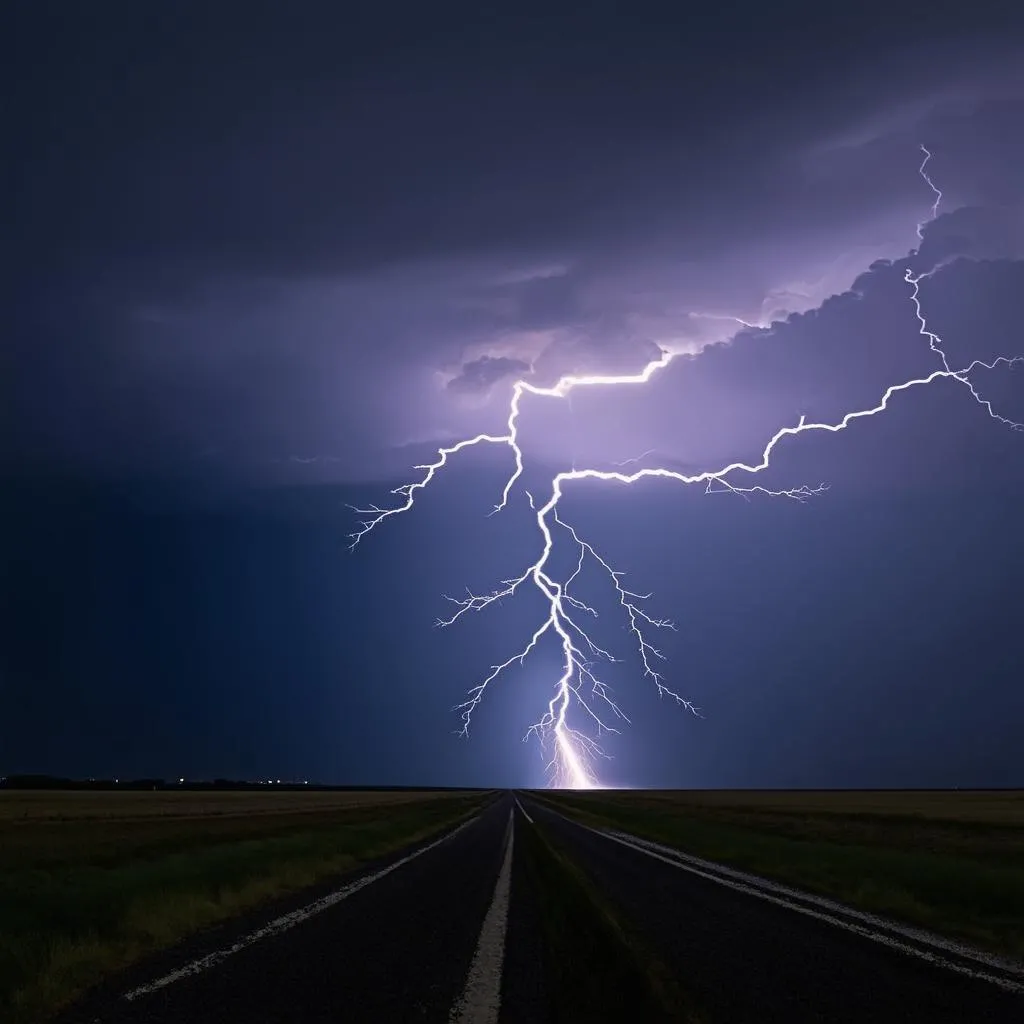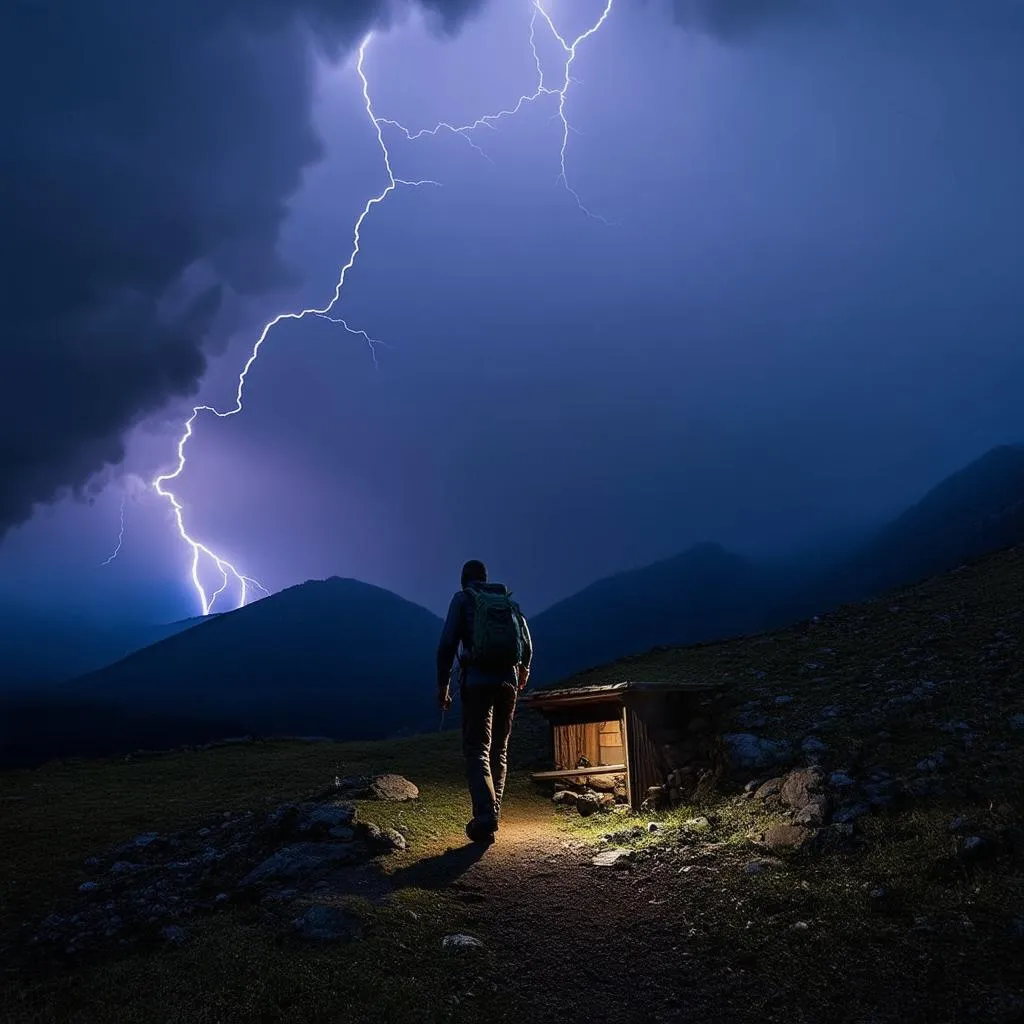Have you ever gazed in awe at a thunderstorm, watching as lightning bolts illuminate the sky? This spectacular natural phenomenon often leaves us wondering about the forces at play. A common question that arises is, “Which Way Does Lightning Travel?” It seems like a simple question, but the answer is a bit more electrifying than you might think.
Decoding the Dance of Electrical Discharge
While it appears that lightning travels from the sky down, the reality is more complex. Lightning’s journey is a two-way street, involving a fascinating interplay of electrical charges.
The Genesis of a Bolt: From Cloud to Ground
- Charge Separation: Inside a thundercloud, a whirlwind of ice crystals, hailstones, and water droplets collide, creating static electricity. This process leads to a separation of charges, with positive charges typically gathering at the top of the cloud and negative charges amassing in the middle and lower portions of the cloud.
- Stepped Leader: The buildup of negative charges in the cloud becomes so intense that it seeks a path of least resistance to the positively charged ground below. This results in an invisible channel of negatively charged air, called a “stepped leader,” zig-zagging downward in stages.
- Positive Streamer: As the stepped leader approaches the ground, objects on the Earth’s surface, like trees, buildings, or even the ground itself, become positively charged and release upward-moving “streamers” of positive charge.
- The Connection: When a stepped leader and a positive streamer connect, a complete electrical circuit is formed. This connection unleashes a surge of enormous electrical current, causing the visible flash we know as lightning. This return stroke travels upward from the ground to the cloud, following the path forged by the stepped leader.
Not Always a Downward Journey: Upward Lightning
While the cloud-to-ground lightning described above is the most familiar type, lightning can also travel in the opposite direction: from the ground to the cloud. This phenomenon, known as “upward lightning,” often originates from tall structures like skyscrapers or antennas. These structures can enhance the electrical field, triggering an upward flow of charge that connects with the negatively charged portions of the storm cloud.
 Lightning Strike from Cloud to Ground
Lightning Strike from Cloud to Ground
The Speed of Light(ning): A Journey at Breakneck Pace
Lightning’s journey is not just about the direction but also about its incredible speed.
- Stepped Leader: The stepped leader travels at an average speed of 200,000 miles per hour (322,000 kilometers per hour).
- Return Stroke: The visible return stroke travels at a staggering speed of around 60,000 miles per second (100,000 kilometers per second) – that’s almost the speed of light!
These incredible speeds are why we perceive lightning as a sudden, instantaneous flash.
Travel Planning and Lightning Safety: Navigating Nature’s Fireworks
Lightning storms can be awe-inspiring, but they also demand respect and caution. Here are some essential tips for staying safe during thunderstorms:
- Seek Shelter: When thunder roars, seek immediate shelter indoors or in a hard-top vehicle.
- 30-30 Rule: Stay indoors for at least 30 minutes after the last clap of thunder.
- Avoid Open Fields: Avoid open fields, tall trees, water, and metal objects, as these can act as conductors for lightning.
Remember, understanding the nature of lightning and following safety guidelines can help you weather the storm and appreciate the power of this electrifying phenomenon from a safe distance.
Common Questions About Lightning’s Travels
Q: Can lightning strike the same place twice?
A: Contrary to the popular saying, lightning can and does strike the same place twice. Tall buildings and other prominent structures are often struck multiple times during a single storm.
Q: How far away is lightning if I hear thunder?
A: You can estimate the distance of a thunderstorm by counting the seconds between the flash of lightning and the sound of thunder. Every five seconds represent approximately one mile of distance.
Q: Can lightning travel through a phone line?
A: Yes, lightning can travel through electrical wiring, including phone lines. It’s best to avoid using corded phones during a thunderstorm.
 Hiker Watching Lightning Storm from a Distance
Hiker Watching Lightning Storm from a Distance
Embracing the Journey: Exploring the World with Travelcar.edu.vn
Just as lightning’s path is full of fascinating twists and turns, so too is the journey of exploration. At travelcar.edu.vn, we’re here to guide you through the wonders of travel, providing valuable information and resources to make your adventures unforgettable.
For more insights into the world around us, explore these related articles:
Let us be your compass as you navigate the globe, discovering new horizons and creating memories that will last a lifetime.